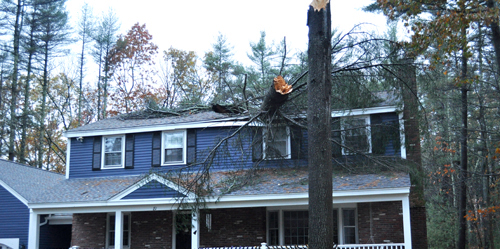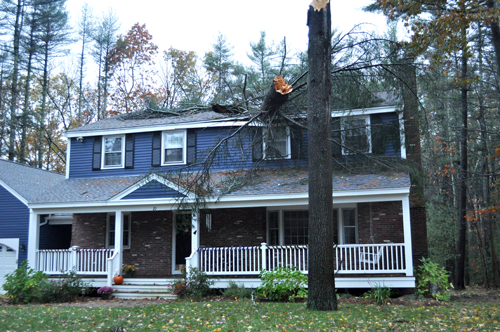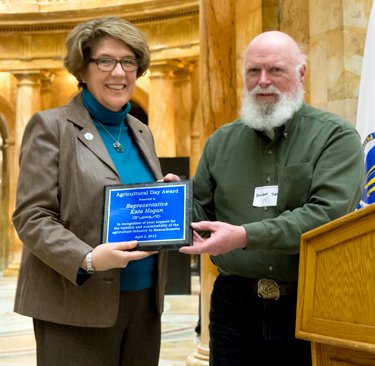

File photo
By Nancy Arsenault
Whether or not you believe that Global Warming is real, evidence suggests that climate change is in the works, with extreme weather and storm situations becoming more common than in recent history.
On April 18, Bolton Local, a grassroots resident group committed to supporting a self-reliant sustainable community will present “Sandy’s Sister is Coming to Town.” The program is designed to help people develop ways to remain resilient in the face of rising weather-related risks affecting family, home, business and the environment.

Courtesy
Representative Kate Hogan of Stow will be there to address the recently released Massachusetts Climate Change Adaptation Report. She will be joined by Kate Baskin of the Massachusetts Executive Office of Energy and Environment, whose department created the multi-faceted document.
“There is broad agreement and high confidence that increased greenhouse gas concentrations are changing the earth‘s climate—not only raising average global temperatures, but more importantly, altering regional and local climatic and weather patterns.
[Greenhouse gases, such as carbon dioxide, are believed to contribute to the warming of the Earth’s atmosphere by reflecting radiation from the Earth’s surface.]
Observed effects of climate change include increased atmospheric and ocean temperatures, heat waves, increased precipitation, and a greater intensity of storms, floods, and droughts,” wrote the researchers in the report.
Temperature
“Statistics show that the the summer of 2010 tied with 1998 as having the warmest global temperature on record. Each year in the 2000s was hotter than average conditions in the 1990s, which, in turn, were hotter than average conditions in the 1980s. Global temperatures could increase by an additional 3.2° to 7.2°F by the end of this century,” predicts the report.
Scientists are predicting that the duration of the winter snow season could be reduced by 50 percent. By late-century, Northeastern cities can expect 60 or more days per year over 90°F under the higher-emissions scenario (not reducing greenhouse gas emissions) or at least 30 such days if conservation and renewable energy efforts are successful. Presently, the region sees about 12 such days a year.
Precipitation
New England is expected to experience changes in the amount, frequency, and timing of precipitation, as these climate changes take place, say the researchers. Since 1900, precipitation across the Northeast has increased on average by 5 to 10%. By the end of the century, under the high-emissions scenario, annual precipitation is expected to increase by 14%, with a slight decrease in the summer—a time when river flows are already low—and a 30%increase in the winter. It is predicted that most of the winter precipitation will be in the form of rain rather than snow.
This change in precipitation type will have significant effects on the amount of snow cover, spring snow melt and peak stream flows, water supply, aquifer recharge, and water quality, according to environmentalists. Large areas of the Northeast are projected to lose more than one-quarter and up to one-half of their snow-covered days toward the end of the century in the high-emissions scenario referenced in the report.
These changes indicate a shift toward more rainy and icy winters with a more regular occurrence of ice storms. These changes in hydrologic cycles would impact water resources, including increased flooding, polluted overflows from stormwater and wastewater systems during high periods of flow, and increased stress on surface and ground drinking water sources during periods of drought and low flow, the state researchers predict.
Their statistics show that extreme precipitation events have increased during the period between 1949 and 2002 in eastern Massachusetts. In 2010, heavy spring rains with three intense rainstorms in March, caused extreme flooding. A number of rivers were at their highest flows since record keeping began. Scientists predict an 8% increase in extreme precipitation events in the northeastern U.S. by mid-century, and up to a 13 % rise by 2100.
What is Happening in Stow?
Warmer temperatures can mean a longer growing season for farmers, possibly supporting new crops and fruits but weather changes may also bring short-term droughts. Agricultural activities could experience compounded impacts due to changes in precipitation and runoff, and increasing weed and pest problems, say these state experts.
Local farmer and Chairman of the Stow Agricultural Commission Dwight Sipler has already seen climate fluctuations affect his farming practices at small farm.
“The historical average last frost for this area is May 15 and the first frost is September 15. Maybe 20 years ago it was generally pretty close to that,” he said. But in the last 10 years, consistent earlier thaws and later frosts have extended his season an additional month on each end.
As for temperature shifts, Sipler said, “Thirty years ago we would get an average of three days or so that got above 90F. We managed to get by without air conditioning then. The last three years we’ve had 25-30 days above 90. Two years ago we had 3 days over 100. We still don’t have A/C but we’d probably like it more now,” he said. Sipler has also noticed far fewer bone chillingly cold days over the recent past. “When we moved here 30 years ago we would have a number of days when the temperature would drop below zero at night and sometimes it would stay below zero during the day. The coldest we saw was -22F. The last 10 years it has rarely dropped below zero and I don’t think there were any days when it didn’t get above zero. At the farm, the frost line would get 12-18″ down back then. Recently it’s stopped around 4-6″. Mud season seems to be shorter now and the fields are usable sooner,” he said.
“The season length and temperatures does affect our crops. Peppers and tomatoes drop blossoms when the temperature is too high. I would not have considered planting tomatoes for September harvest back then. Now I plant some for October harvest,” he concluded.
State Representative Kate Hogan said, “Last year I served as vice-chair of the Joint Committee on Energy and heard testimony that spoke volumes to the increase in severity of storms we experience and the damage that is done by them. There are bills on a local level as well as strategies put forth by the forward thinking UMass Extension Service. We have local groups in all four of my towns working to support legislation and organize locally to address ways to save energy and protect the planet. Climate change is no longer a conversation, but rather, a reality we will be dealing with in the coming years.”
For further discussion on the topic, the public is welcome to attend “Sandy’s Sister is Coming to Town” on April 18 at 7pm in the Bolton Public Library.